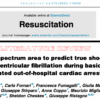We often talk about being able to predict the difficult airway. How useful is this really? In the scheme of things the Emergency Airway is just that, an emergency. Working out if the airway is potentially difficult or not, does not change the fact that the airway will need to be controlled in some way. The Emergency Airway is unlike the elective procedure-related anaesthetics airway. In those cases in theatre, the patient has usually attended a pre-op anaesthetics clinic and been reviewed. In theatre if there is an issue with the airway,  the patient, who in most cases is fasted, can be allowed to wake up and the procedure may be put off until another day.
In the emergency department this cannot be done, as the reason that that patient needed to have the airway secured in the first place, is still there! Also, most of our patients have a belly full of pizza and beer!
Having some way to predict, if an airway may be challenging, is still worthwhile however, as it puts us in a frame of mind, that we may encounter difficulty. The best way to be in any airway situation is to assume that every airway scenario is a potentially difficult one.
In the Airway Workshop we talk about the ‘LEMON’ approach and cover the main aspects of it:
L – Look externally, is the patient obese, is there a beard etc.,
E- Evaluate the 3-3-2 Rule
M-Mallampati
O-Any chance of an obstruction- infection, tumour etc.
N-Neck mobility
The ability to assess a difficult airway in my view comes down to two or three things:
1  Is there good neck mobility to allow you to move the head so as to align you oral, pharyngeal and laryngeal axes?
A trauma patient in a collar, is automatically classed as a potentially difficult airway.
2  Is there adequate distance(3 fingers) from tip of the chin to the hyoid bone?
This tells you if there is adequate space for you to displace the tongue into. Remember that the tongue is your foe.
It is the thing that drops back and blocks the airway. You must move it out of the way to get access to the chords.
3  What is the patients mouth opening like? Is there enough room to get in there?
In most cases you will still be able to intubate with a normal curved #3 blade and a 7.5 endotracheal tube with and introducer, the end bent at about 40 degrees. These are the cases however when I have a bougie at the ready.
You will hear me speaking about forgetting about your difficult intubation box!
I have serious concerns about difficult intubation boxes. We have them in our emergency departments and somehow everyone believes that these will have something magical in them to save us at the time of a difficult intubation. The things we don’t remember as educators, is that most people don’t practice difficult intubation, don’t use what is in those boxes frequently enough to be confident with them. If they do, it may be once per year, which is not enough. If you are a registrar, you may rotate through many departments and I can assure you that each will have a different set of contents in the difficult intubation box.
At that point of crisis, there is no time for you to work out what is in the box and certainly this is not the time to use something for the first time. It is the time to have your basic technique right.
I will always teach the use of :
-The curved #3 blade
-7.5mm ETT
-Introducer
-Bougie
-Know one or two other techniques such as the ‘ILMA’ or the ‘Airtraq’ as many departments will have one or other.
-Know your needle cric and surgical cric techniques.
Remember, assume every airway will be a difficult one, know the basics well and you will be able to intubate just about every patient and have one or two rescue techniques up your sleeve.
Good luck with those airways.
Here’s a glimpse of some nice comments made by people who have attended the workshop. Their kind words are really appreciated.










